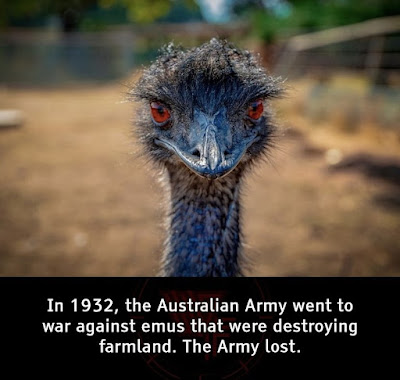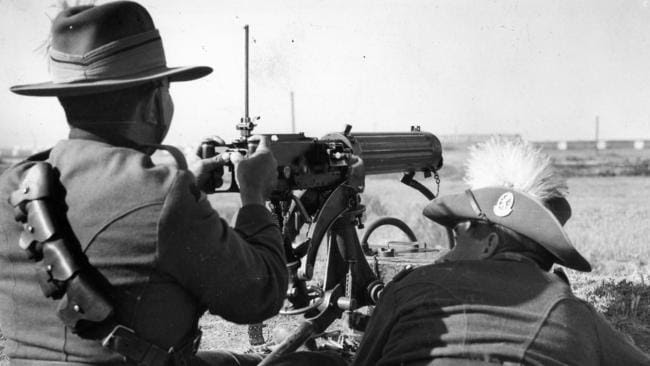In 1930s Australia, it was decided that there were too many Emus out in the western bush, and so Australia's military armed itself with Lewis machine guns, and went out to war with the birds .... and promptly lost.
The Great Emu War of 1932, was waged to address public concern that there were a large number of emus "running amok" in the Campion district of Western Australia. In truth, the Emus (as many as 20,000) had invaded because farmers had made stock tanks and ponds for water and planted an abundance of wheat.
Despite having machine guns and vehicles, the Australian military only managed to kill fewer than 1,000.
Years later, The Sunday Herald reported that Major Meredith had found the emus almost impossible to defeat.
Following their battle field defeat to the emus, the Australian government decided to incentivize local farmers to engage in self-help using a bounty system.
The Great Emu War of 1932, was waged to address public concern that there were a large number of emus "running amok" in the Campion district of Western Australia. In truth, the Emus (as many as 20,000) had invaded because farmers had made stock tanks and ponds for water and planted an abundance of wheat.
Despite having machine guns and vehicles, the Australian military only managed to kill fewer than 1,000.
Part of the problem was that the birds were so fast that, no matter how many were gathered in one spot, after the first few shots they’d all scatter faster than any man could run.
At one point, Meredith ordered a Lewis gun to be mounted on the back of a truck to try to keep up with the running birds. It still didn’t work — it turns out that a truck that can do 65 mph on a paved road struggles to make 20 mph over rough land, and you can’t stabilize a machine gun on a static mount or shoot with any accuracy. Worse, a single truck can only chase one emu at a time, and the hundreds of others will invariably run away from the vehicle, making a clean getaway almost every time.
Years later, The Sunday Herald reported that Major Meredith had found the emus almost impossible to defeat.
“If we had a military division with the bullet-carrying capacity of these birds it would face any army in the world,” he was quoted as saying. “They can face machine guns with the invulnerability of tanks. They are like Zulus whom even dumdum bullets could not stop.”
The paper also quoted another emu-hunter as saying: “There’s only one way to kill an emu — shoot him through the back of the head when his mouth is closed, or through the front of his mouth when his mouth is open. That’s how hard it is.”
Following their battle field defeat to the emus, the Australian government decided to incentivize local farmers to engage in self-help using a bounty system.
Instead of brute-forcing the culling of emus, the government set aside money for bounties and let the farmers themselves do the hard work of tracking and shooting the emu menace. This was much more effective. In 1934 alone, nearly 58,000 bounties were claimed.


No comments:
Post a Comment